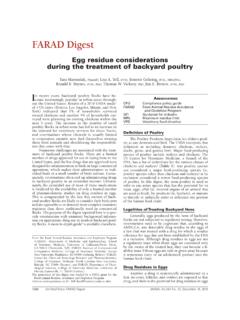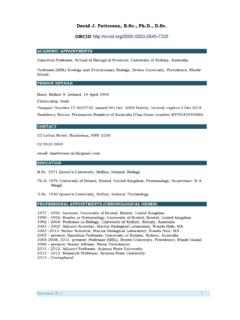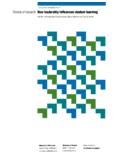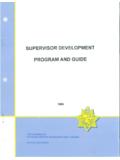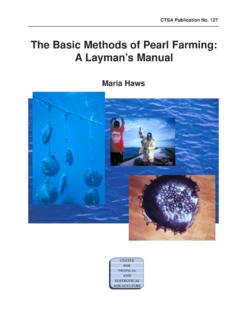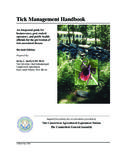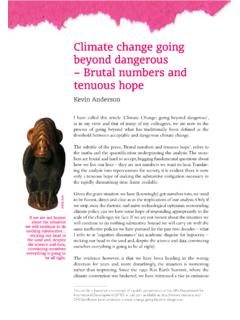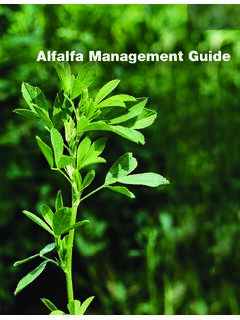Transcription of FARAD Digest
1 668 Vet Med Today: FARAD Digest JAVMA, Vol 217, No. 5, September 1, 2000 TheFood Animal Residue Avoidance Databank( FARAD )access centers in the United States havebeen contacted in recent months about the extralabeluse of several macrolide endectocides. The focus of thisarticle is to provide an update on approved use of thesedrugs. Caution should be exercised with extralabel useof this class of drugs, particularly with moxidectin andivermectin used in dairy animals. Macrolide endecto-cides are popular in livestock operations, because theyare generally efficacious against most important inter-nal and external parasites, and approved topical for-mulations can improve producer compliance. Because many macrolide endectocides arelipophilic, substantial concentrations will be found inedible tissues.
2 As much as 5% of the administered drugcan be secreted in eprinomectin and mox-idectin pour-on formulations are approved for use indairy cattle. This is because of the intrinsic chemicalbehavior and unique formulation chemistry of these 2drugs. Ivermectin and doramectin are not approved fordairy animals, and their meat withdrawal times arelong, compared with other less lipophilic disposition data of milk and plasma ivermectinindicates a milk:plasma area under the curve (AUC)ratio of for with approved oraland subcutaneous routes of administration, approvedtopical application can result in less absorption butextended meat withdrawal times, because the dermalabsorption process is rate limiting, and depletion ofresidues to established tolerances is prolonged. Thesepharmaceutical and pharmacokinetic differences arereflected in the approved withdrawal times (WDT;Table 1).
3 Extrapolated Withdrawal-intervalEstimation MethodsThis article will focus briefly on specific FARAD cases or requests for information regarding extralabeluse of ivermectin and moxidectin and the processinvolved in deriving recommended withdrawal inter-vals (WDI). The FARAD -derived WDI are based onpharmacokinetic data summarized in the FARAD data-base, which were published in peer-reviewed journals,FDA freedom of information summaries, and Food andAgriculture Organization monographs (Table 2). Withcomplete data sets, the WDI are extrapolated from tis-sue kinetic information and the approved WDT. Thelatter are calculated by statistical analysis of tolerancelimits containing the 99th percentile of the test animalpopulation with 95% confidence. The FARAD has des-ignated these extrapolated withholding times as WDIto differentiate them from WDT, which are approvedby the US FDA.
4 The WDI estimates are based on theeffective residue half-life (ERH) derived from tissuekinetic ,4 Extralabel Use of IvermectinOral route in goats Ivermectin is not approvedfor use in goats in the United States. However, thelabeled drench dose for sheep ( mg/kg of bodyweight [ ]) has an 11-day meat WDT. This issupported by an observed fat and liver depletion half-life of days for the intraruminal route in sheep,5recalling that it generally requires about 10 half-lives toeliminate 99% of the drug. Several studies furtherdemonstrated that following intraruminal administra-tion in goats,6bioavailability was times lower andthe plasma half-life was times shorter than pharmacokinetic differences were notobserved with doses administered the basis ofthese supporting data, FARAD estimates that if the oraldrench approved for sheep is administered to goats atthe labeled dose for sheep, then a meat WDI of 11 daysshould prevent meat residues in goats.
5 If ivermectin isadministered at up to to times the labeled dosefor sheep, as is the common practice, then the WDIneeds to be extended by at least 1 extra ERH. Based onthe WDT for sheep, and in the absence of tissue deple-tion data for goats, FARAD assumes an ERH of daysobtained by dividing the WDT by a half-life multiplier(HLM)value of ,4 The HLM represents the number ofERH needed for the concentration in tissue to reachthe tolerance level. In summary, FARAD recommends ameat WDI of 14 days for up to mg/kg ( mg/lb) FARAD DigestFrom the Food Animal Residue Avoidance Databank ( FARAD ),Department of Farm Animal Health and Resource Management,College of Veterinary Medicine, North Carolina State University,Raleigh, NC 27606 (Baynes, Martin-Jimenez, Abdullah, Anderson,Riviere); the Department of Environmental Toxicology, Universityof California, Davis, CA 95616 (Payne, Craigmill); and theDepartment of Physiological Sciences, College of VeterinaryMedicine, University of Florida, Gainesville, FL 32610 (Webb).
6 Extralabel use of ivermectin and moxidectin in food animalsRonald E. Baynes, DVM, PhD; Michael Payne, DVM, PhD; Tomas Martin-Jimenez, DVM, PhD, DACVCP;Ahmed-Rufai Abdullah, DVM; Kevin L. Anderson, DVM, PhD, DABVP; Alistair I. Webb, DVM, PhD, DACVA;Arthur Craigmill, PhD; Jim E. Riviere, DVM, PhDJAVMA, Vol 217, No. 5, September 1, 2000 Vet Med Today: FARAD Digest669per os. These calculations assume that the kinetics ofivermectin are linear. The milk WDI would be 6 daysbased on a study by Scott et al,8that demonstrated thatat 6 days, goats milk was clear of the drug after an oraldose of mg/kg. Based on this information, oraladministration up to mg/kg will require a milkWDI of at least 8 days in dairy goats. Oral route in cattle Ivermectin has the same half-life in cattle as it does in sheep; however, because of alarger volume of distribution, plasma clearance is morerapid in these reasons, WDT and WDI willbe shorter in sheep and goats than in cattle.
7 Surprisingly,there is limited depletion data for oral administration ofivermectin in cattle. Following intraruminal administra-tion in cattle, depletion half-lives for 3H-ivermectin in fatand the liver were and days, a longer meat WDI (42 days) for the intraru-minal route than the approved meat WDT (24 days)with the approved oral paste. Plasma data from thatstudy demonstrated a plasma concentration of ng/mlof total residues at 21 days and undetectable at 28 daysafter a mg/kg dose. In the absence of milk residuedata, it is possible to estimate a conservative milk WDIof 28 days if we assume parallel depletion for plasmaand milk and use published data in which the milk:plas-ma AUC ratio is in WDI will be con-servative for oral administration, as the WDI was basedon intraruminal administration of a3H-labeled drug anda dose greater than the approved route in goats Ivermectin wasdetected up to 25 days in milk from lactating goats mg/kg were no differences between plas-ma and milk pharmacokinetic variables, and themilk:plasma AUC ratio was , as stated earlier.
8 Theelimination half-life was 4 days for plasma and milk, andit would take 40 days (10 half-lives) to eliminate 99% ofthe drug via milk when administered by this tissue residue data from an NRSP-7 study10pro-vided an ERH of days (ke= days-1) in fat,which is the slowest depleting tissue. Application of ouralgorithm resulted in a WDI of 22 days. As this FARAD estimate is less than the cattle WDT, and there were lim-ited available data, we recommend the cattle WDT of 35days for an extra margin of safety. Subcutaneous route in cattle Ivermectin wasdetected in milk at days and even beyond 29 dayswhen lactating cows were given mg/kg milk depletion half-life was days, whichsuggests that it would take at least 47 days to eliminate99% of the drug via the milk. As seen with goats, a par-allel disposition in milk and plasma was observed, andDose (mg/kg ofMeat WDTMilk WDTDrugSpeciesRoutebody weight)(days)(days)IvermectinBeef cattleOral cattleSC or and dairy and dairy Not 1 List of approved macrolide endectocides for specific species and routes andapproved withdrawal times (WDT)DairyDose (mg/kg ofMeat WDIMilk WDID rugspeciesRoutebody weight)(days)(days) * * * * * * *14 NAGoats * * * *0*0*FDA approved withdrawal times.
9 NA Not available. Table 2 Food Animal Residue Avoidance Databank recommended withdrawal inter-vals (WDI) for ivermectin and moxidectin in dairy species670 Vet Med Today: FARAD Digest JAVMA, Vol 217, No. 5, September 1, 2000the milk-plasma AUC ratio was These data andWDI estimates are further supported by the observedplasma half-life of days in another study of sub-cutaneous administration in route in goats Topical application ofivermectin ( mg/kg [ mg/lb]) to dairy goatsresulted in about ng/ml of milk at 6 residues were not detected at 7 days, this time canbe used as a milk WDI for goats given ivermectin top-ically. Tissues were not assayed, but plasma concentra-tions were less than ng/ml at 6 days, supporting themilk-plasma relationship described. Topical route in cattle There are no availablestudies on topical application of ivermectin in dairycattle.
10 However, plasma concentrations were less ng/ml at 42 days, and terminal half-life in plasmawas days in steers treated topically at the that milk-plasma ratios were ,as described earlier, milk concentrations at 42 daysshould be ng/ml, and it would take at least 2more half-lives (11 days) to arrive at a milk concentra-tion of approximately ng/ml. This milk concen-tration is equivalent to a safe concentration or a provi-sional acceptable residue for ivermectin in milk recent-ly described in the on these data andassumptions, a milk WDI of 53 days would be a con-servative estimate for dairy cattle exposed to iver-mectin pour-on. Extralabel Use of MoxidectinOral route Moxidectin is not approved for use ingoats. Several goat farmers have been administeringmoxidectin to goats orally at the labeled pour-on dose( mg/kg) for cattle.




